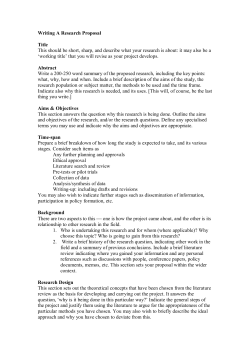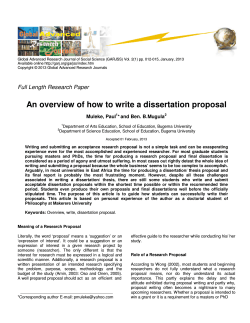
42 BAB III RESEARCH METHOD According to Arikunto, method
42 BAB III RESEARCH METHOD According to Arikunto, method represents a compulsion to be used in the study and it is a way that is used by the researcher in the collecting data. In order to give valid and reliable data, the research method is very important for a research and for accurate data.78 The research design, setting of the study, research procedure, data and source of data, data collection technique, research instrument, and data analysis are discussed in this chapter detail. A. Research Design To identify, describe, analyze and classify various types of errors based on Betty Schrampfer Azar’s error analysis category made by learners, the researcher uses quantitative descriptive study as design of this study. The quantitative descriptive study is designed to provide systematic information about a phenomenon. The researcher does not usually begin with an hypothesis, but is likely to develop one after collecting data.79 It can be tabulated along a continuum in numerical form, such as scores on a test or the number of times a person chooses to use a-certain feature of a multimedia program, or it can describe categories of information such as gender or patterns of interaction 78 79 Arikunto, Suharsimi, Prosedur Penelitihan,(Jakarta: Rineka Cipta,2002),136 Johnson & larry, Educational Research Qualitative,Quantitative and mix approaches second edition,(Boston;Pearson Education, 2004), 359 42 43 when using technology in a group situation.80 The descriptive study is aimed to get information about the student’s error on the writing task. In this study, the researcher analyzes in the writing II task made by the third semester students of English Department of IAIN in academic year 2012 to get the data and the researcher analyzes the result of the task to find out the types of error that they make. B. Setting of The Study In the research Method, setting is one of the parts which play an important role. It includes place and time. Setting of the place of the study is at English Education department or familiarly called “PBI” at Education Faculty (Tarbiyah Faculty) in State Institute of Islamic Studies (IAIN) Sunan Ampel Surabaya. It is located in Jl. A. Yani 117 Surabaya. PBI includes a new department in IAIN as it is firstly developed from year 2005. This department has a vision. It is to be English Education Department that has popular level best in field of education and development of language, research and society dedication. Besides, it also has a mission includes: creating the students become English teachers who have high quality, good attitude, adequate knowledge and ability to teach, conducting an establishment and have 80 The Association for Educational Communications and Technology, Descriptive Research, ( Bloomington: North Stonelake Drive,2001) 44 high qualified research in the field of language and language teaching.81 This study was held on January after collecting students’ writing II task from the final semester examination. There are three classes in writing II subject. It consists of 89 students. According to Arikunto, we can take the subject as sample between 10-15 % or 20-25% if the number of subject is large.82 In this study, the researcher collects 18 students’ writing II task from Mr. Sigit Pramono M.Pd as the lecturer of writing II. C. Data and Source of Data According to Arikunto, the collecting data techniques include questionnaire, interview, observation, test and documentation.83 In this research, the researcher uses documentation and interview. The document is used as the collecting data technique to get data which is studied about the error types based on Azar’s error analysis category. The document in this study is the writing II task by the third semester students of English Department of IAIN in academic year 2012. The source of the data are students and lecturer. The researcher also uses interview to know the possible cause of grammatical error which students make. In this study, the researcher uses the highest 81 Profile of PBI, (http://www.pbi.sunan-ampel.ac.id/, accessed on January 11, 2013) Arikunto, Suharsimi, Prosedur Penelitihan……….…….112 83 Arikunto, Suharsimi, Prosedur Penelitihan…………….197 82 45 percentages of grammatical error analysis category as base in interviewing the students. D. Research Instrument The researcher uses himself as the key of instrument. In this case, Lincoln and Guba say: “The instrument of choice in naturalistic inquiry is the human. We shall see that other forms of instrumentation may be used in later phases of the inquiry, but the human is the initial and continuing mainstay. But if the human instrument has been used extensively in earlier stages of inquiry, so that an instrument can be constructed that is grounded in the data that the human instrument has product.”84 The instrument of the study is document and interview. The first instrument is document. It is the third semester students’ writing II task of English Department of IAIN in academic year 2012. The writing II task is used to find out data because it contains of some grammatical errors. Table 3.1 Checklist Table Resp. Freq The Categories of Grammatical Error 1 2 3 4 5 6 7 8 9 10 11 12 13 Total NOTE: 1= singular-plural 4 = verb tense 84 2 = word form 5 = add & omit a word 3 = word choice 6 = word order Sugiyono, Metode Penelitian , Pendekatan Kuantitatif, Kualitatif, dan R&D (Bandung: Alfabeta, Cv., 2010), 306 46 7 = incomplete sentence 10 = capitalization 13 = run-on sentence 8 = spelling 11 = article 9=punctuation 12= meaning not clear The researcher also uses the interview as the second instrument because the researcher wants to know the possible cause of grammatical error which students make. In this study, the researcher uses free guided interview. Free guided interview is interview done by bringing the question guidance but the researcher can ask the Students everything relating to data needed.85 For efficiency of the time, the researcher interviews the students orally to get information about the possible cause of grammatical errors which they made. Table 3.2 Checklist Table No The Categories of Grammatical Error Analysis The Possible Cause Interlingua OG Intralingua IORS IAOR FCH NOTE: OG = over-generalization IORS = ignorance of rules restriction IAOR = incomplete application of rules FCH = false concept hypothesized. E. Data Collection Technique Collecting data can be done in various setting, sources and ways.86 To collect the data, the researcher refers to the research problem. The researcher will permit the lecturer to ask the students’ writing II task on the final semester 85 86 Arikunto, Suharsimi, Prosedur Penelitihan…………….132 Sugiono, Metode Penelitian ……………….137 47 examination. After that, the researcher reads the writing II task deeply and looks for the errors. The researcher classifies the error types based on Betty Schrampfer Azar’s error analysis category classified into: singular-plural, word form, word choice, verb tense, add and omit a word, word order, incomplete sentence, spelling, punctuation, capitalization, article, meaning not clear and run-on sentence after knowing all grammatical errors from the writing II task. The next step is the researcher counts the frequency and percentage each category based on the formula used. After knowing the percentages of grammatical errors which students made, the researcher selects the highest percentages of grammatical error analysis category as a base in finding the possible causes of grammatical error which students make. It is done by interviewing the students who make the grammatical error. In this interview, the researcher uses two factors that cause the occurrence of error: Interlingua errors and intralingua errors.87 It is related with the highest percentages of grammatical error analysis category. In conducting interview, there are some ways.88 It is directly conducted face to face when the researcher meets the students at Campus. In addition, the researcher invites the students to meet in very relax situation like having lunch in the canteen while having informal chat. Even the researcher also interviews by 87 88 Jack C. Richards, A non‐Contrastive Approach to Error Analysis……………….172‐181 Sugiono, Metode Penelitian ……………….138 48 calling the students. Overall, these interviews are done informally in order that the interviewees do not realize that they are being interviewed and investigated so the students can explore their ideas, feeling, insights, expectations or attitudes. The researcher also records the interviews with cell phone and then it is transcribed later after conducting interviews. F. Procedure of Data Analysis To get valid data, the researcher uses Error Analysis theory suggested by Corder. According to Corder, there are three steps of error analysis: recognition, description and explanation of error.89 The analysis procedures of the writing II task made by the third semester students of English Department of IAIN Sunan Ampel are as below: Table 3.3 The steps of error analysis No Steps 1 Explanation Collection samples of of the Deciding what samples of learner learner language to use for the analysis and language 2 Identification errors 89 how to collect these samples of the Identifying the errors by underlining the errors which the learner made Corder, S.P.,The Significance of Learners’ errors.(International Review of Applied Linguistic 5.1967) ,160-170 49 3 Classification of the Grouping the errors that have been errors 4 Explanation found and stating the classes of the Explaining the errors by establishing errors the source of the errors and calculating how often the errors appear 5 Evaluation of the errors Evaluating the errors step involves making table and drawing conclusion From the steps of error analysis above, the data is analyzed as follow: 1. Identification of the errors In this step, the researcher studies the acquired data and tries to find out the grammatical errors by underlying the errors. The researcher tries to analyze the data as objective as possible. 2. Classification of the errors Once the errors have been identified, the researcher classifies them based on Betty Schrampfer Azar’s error analysis category, they are: a. Singular-Plural b. Word Form c. Word Choice d. Verb Tense 50 e. Add And Omit A Word f. Word Order g. Incomplete Sentence h. Spelling i. Punctuation j. Capitalization k. Article l. Meaning Not Clear m. Run-On Sentence. 3. Calculation of the errors In this step, the researcher calculates the errors in order to know how frequent these errors have been made by the third semester students. In calculating the frequency of these each error, the researcher employs the following formula: Number of error each type _________________________________ X 100% The total number of errors of each type By calculating the frequency of each error, the researcher can identify the most frequent error and the least frequent error made by the students. Then the researcher describes the result of each type of errors to make it clear. 51 4. Making table result Once The errors are calculated and arranged the table result of the analysis. This table is meant to make easy the identification of the percentage of each error. Therefore, the result of the analysis of the grammatical errors in students’ writing II task is presented in the form of a table. Table 3.4 The error type of Betty Schrampfer Azar’s error analysis category Student s Error Possible Revision Freque ncy Perce ntage 1 You can communication with someone You can communicate with someone 1 0,26 5. Drawing a conclusion The next step would be drawing a conclusion based on the analysis. In this step, the researcher makes valid conclusion in the form of a brief description of the errors. 6. Describing the cause of error After knowing the percentage of grammatical errors which students make, the researcher selects the highest grammatical error category percentages as a base in finding the possible causes of grammatical error which students make. It is done by interviewing the students who made the 52 grammatical error. In describing the cause of error, the researcher uses the result of interviewing the students.
© Copyright 2025









